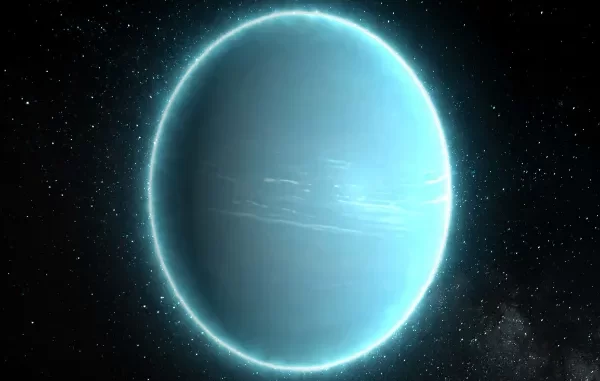
Welcome kids to the fascinating world of Uranus! This planet is the seventh planet from the Sun and it is full of surprises!
Here are five interesting facts about Uranus that will surely wow and amaze you:
- Uranus is the seventh planet from the Sun and the third largest in the solar system.
- Uranus is the only planet that rotates on its side, meaning it has an axial tilt of 97.77 degrees!
- Uranus has 27 known moons, the most interesting of which is Miranda, whose surface is full of strange-looking features.
- Uranus has a ring system made up of 13 rings.
- Uranus has an atmosphere made up of mostly hydrogen and helium with a small amount of methane. So, now you know that Uranus is a pretty cool place!
Uranus is the seventh planet from the Sun and is the third largest planet in our Solar System.
Uranus is the seventh planet from the Sun and is the third largest planet in our Solar System. It is composed of a combination of various gases, primarily hydrogen and helium, with traces of methane and water vapor.
Uranus has a number of features that distinguish it from other planets in our Solar System, such as its unique axial tilt of 98 degrees, which causes it to have extreme seasonal variations. It also has a much longer rotation period than other planets, taking about 17 hours and 14 minutes to complete one rotation.
Uranus has a number of moons, including Titania, Oberon, Ariel, Umbriel, and Miranda. It also has a set of faint rings composed of dust particles and rocks. Uranus is an interesting and mysterious planet, and it continues to fascinate scientists and astronomers alike.
Uranus is the only planet that rotates on its side.
Uranus is the only celestial body in the Solar System that rotates on its side. It orbits the Sun at an angle of 98 degrees, meaning its axis of rotation is tilted almost parallel to the plane of its orbit.
This unique orientation is thought to be the result of a massive collision with a large planetary-sized object in the distant past. This collision would have caused the planet’s rotation axis to shift drastically.
The result is that the planet’s north and south poles are located where its equator would be on other planets.
Uranus has 27 known moons, the most notable of which is called Miranda.
Uranus is a gas giant in our Solar System discovered in 1781 by English astronomer William Herschel. It has 27 known moons, the most notable of which is called Miranda.
Miranda is the smallest and innermost of Uranus’ moons, and it was discovered in 1948 by Gerard Kuiper. It is characterized by its highly irregular shape and terrain, which is believed to have been caused by an enormous collision in its distant past.
Miranda is composed of roughly equal amounts of silicate rock and ice, and it has an average radius of 236 km. Its surface is home to numerous canyons, cliffs, and ridges.
Uranus is made up mostly of ice and gas and has a faint blue hue due to the methane in its atmosphere.
Uranus is composed primarily of ice and gas, and its atmosphere contains an abundance of methane that gives it a faint blue hue.
This gas giant is one of the outermost planets in the Solar System and is the seventh planet from the Sun. Uranus is best known for its unique rotation, as it rotates on its side relative to the other planets in the Solar System.
Uranus was not discovered until 1781, when it was spotted by astronomer William Herschel.
In 1781, the astronomer William Herschel discovered the planet Uranus, marking the first time the celestial body had been observed.
Herschel’s remarkable achievement was a milestone in the history of astronomy, as Uranus became the first planet to be discovered since ancient times. With its discovery, Herschel expanded our understanding of the solar system and inspired generations of astronomers to come.
Leave a Reply